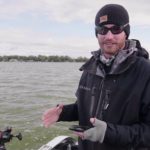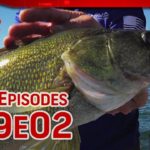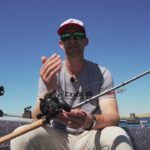Head South for More Walleyes
 If you develop an itch to get in some early season walleye action you can scratch it by looking for a warmer climate and taking a due south heading. There are plenty of opportunities for open water walleye spread throughout the south and includes states like Arkansas, Missouri, and even Kentucky. While the South and good walleye fishing aren’t exactly synonymous it is a possibility, especially if you know a little about the when, where, and how.
If you develop an itch to get in some early season walleye action you can scratch it by looking for a warmer climate and taking a due south heading. There are plenty of opportunities for open water walleye spread throughout the south and includes states like Arkansas, Missouri, and even Kentucky. While the South and good walleye fishing aren’t exactly synonymous it is a possibility, especially if you know a little about the when, where, and how.
Big southern reservoirs like Cumberland in Kentucky, Lake Norfork and Bull Shoals in Arkansas, and Lake Stockton in Missouri are just a few of the bodies of water that have fishable numbers of walleyes. Fishable numbers means that there’s enough walleyes present to make it worth your while to pursue. Without the numbers you can feel like your looking for a needle in a haystack, which can be a little frustrating. You better believe the numbers are there, even more than you might think.
For example; Bull Shoals was on last year’s list of tournament sites for the In-Fisherman Professional Walleye Trail and there was a little apprehension going in. Southern tournaments in the past have made for tough fishing, although we did catch at least a few fish and learn something every time we made a trip. Bull Shoals really opened the eyes of everybody that participated in the tournament and the action was exceptional. So much so that is was the best fishing we had during the entire season, including all of the tournaments held on the tremendous fisheries of the North. Everybody has a favorite lake to fish and Bull Shoals has made it’s way into my top ten list, and maybe even top five.
Making a southern run early in the season can put you in the right place at the right time and be a peak time of the year for finding schools of walleyes bunched up in areas that are easy to identify. Even though the spawning season is not usually associated with good walleye fishing, it’s one of your best bets for finding heavier concentrations of fish.
Southern walleyes behave like they do anywhere else, and the spawning season is no different. Classic movements include upstream migrations that lead walleyes up incoming rivers, as well as to the back ends of coves and arms with feeder creeks.
 Once the actual spawning has taken place walleyes can be expected to hang around for several weeks or more, before slowly filtering back into the main lake. They’ll hang around because that’s where most of the baitfish can be found; seeking out the warmer temps that shallow water can provide.
Once the actual spawning has taken place walleyes can be expected to hang around for several weeks or more, before slowly filtering back into the main lake. They’ll hang around because that’s where most of the baitfish can be found; seeking out the warmer temps that shallow water can provide.
Warmer water temperatures is a draw for many species of fish, including walleyes, bass, stripers and crappies. In fact walleyes may be in the minority, but don’t let that bother you. Catching bass, stripers, and giant crappies can provide plenty of action and fun, and will help keep you entertained during your search for southern gold.
Because of so many other species that might be available solely relying on your electronics to find walleyes becomes an impossibility. While they can help determine the presence of bait and predators, they can’t determine the species. On the other hand good electronics like the Raymarine C120 are still a must for finding underwater shelves and points, as well as baitfish and game fish, no matter what it is.
 The Raymarine C120 has an incredibly brilliant 12 inch color display that can combine DFI (which is High Definition Fish Imaging), along with G.P.S. and even radar. The HDFI can actually breakout and display individual bait fish in a school and show you much more of what you’ve been missing. The G.P.S. chart plotter can use and display the Navionics Gold maps which will help keep you from getting lost and into trouble, especially when you’re on a body of water you’ve never been on before. On many of the big reservoirs every arm and bay looks the same and it’s much too easy to get confused. With the Navionics map displayed you know exactly where your are, where you’ve been, and all in relation to any structure or contour line that you might be over.
The Raymarine C120 has an incredibly brilliant 12 inch color display that can combine DFI (which is High Definition Fish Imaging), along with G.P.S. and even radar. The HDFI can actually breakout and display individual bait fish in a school and show you much more of what you’ve been missing. The G.P.S. chart plotter can use and display the Navionics Gold maps which will help keep you from getting lost and into trouble, especially when you’re on a body of water you’ve never been on before. On many of the big reservoirs every arm and bay looks the same and it’s much too easy to get confused. With the Navionics map displayed you know exactly where your are, where you’ve been, and all in relation to any structure or contour line that you might be over.
 If you know where you are and you’re where you want to be, the only way to know for sure if there are any walleyes around is to put a fish or two in the boat, and when the fun really begins. There’s more than one way to get the job done, but a spinner and crawler rates high on the list. Leeches have also proven to be extremely productive but are next to impossible to find so early in the season.
If you know where you are and you’re where you want to be, the only way to know for sure if there are any walleyes around is to put a fish or two in the boat, and when the fun really begins. There’s more than one way to get the job done, but a spinner and crawler rates high on the list. Leeches have also proven to be extremely productive but are next to impossible to find so early in the season.
A spinner and live bait combination behind a bottom bouncer will allow you to cover some water and give the bait a small amount of speed. Early season post spawn walleyes can be caught; It’s simply a matter of keeping a solid presentation in the right place.
The back ends of creek arms can be loaded with debris including trees, brush, rocks and shale, all of which will give you fits if you’re not prepared. Getting a bouncer and spinner through that kind of stuff can be tough to say the least, but is possible with a minor adjustment. Simply shortening up your snell length will help keep your bait from dragging on the bottom and can make a real difference in how much time you spend hung up and re-tying.
Good places to drag a bouncer includes shallow flats, break lines, and near the edge of flooded brush and vegetation. The key is trying to cover everything as location can vary from day to day and you just don’t know for sure.
Pitching jigs to shallow brush or vegetation is another option, and may be a good choice if you feel spooking may be a factor. Spooking can become a real problem if you’re working shallow water, especially if it’s relatively clear.
Although walleyes are often thought of as being most active early in the morning and late in the day it’s not always so, especially early in the season. In fact, activity will often increase as the sun gets higher and the shallows start to warm up. It can also bring walleyes into extremely shallow water, like a few feet or less. It’s a factor to be aware of, and a solid game plan will always include a good amount of shallow water.
An early season southern run may be just the ticket to get a jump on the upcoming season. Sure, there may be open water walleyes closer to home, but the ability to shed a few layers of clothes and fish in a light jacket or even short sleeves can be well worth the trip. The combination of a warmer climate and southern hospitality may get you hooked, and keep you coming back for more, year after year.





